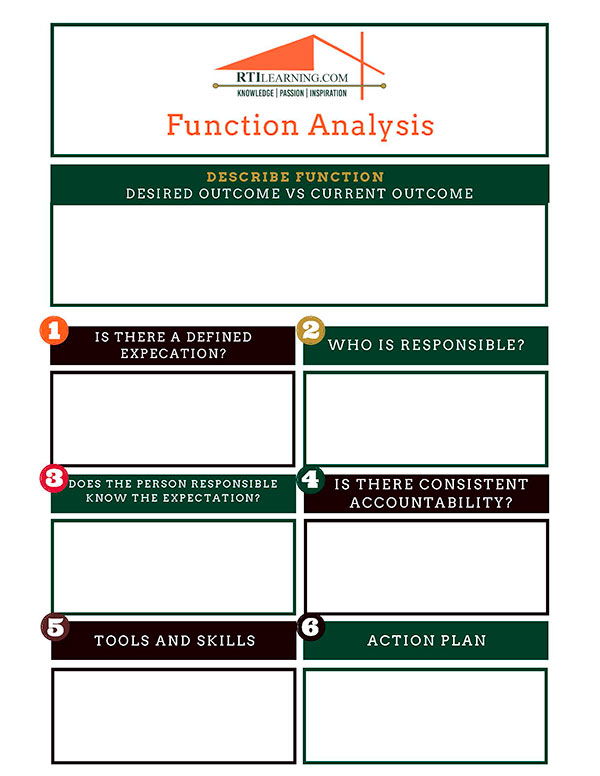
Lisa Lavender, M.T.R., M.F.S.R., M.W.R.
In many cases, when leaders notice dysfunction, something goes wrong or someone does not meet an expectation, it is necessary to resist the blame game and begin by “rolling it uphill.”
The objective is to bring about improvement and/or desired results. We may have all been guilty, at one time or another, of proclaiming:
- “They just don’t care!”
- “They don’t know what they are doing!”
- “They are just lazy!”
It is unproductive and will not lead to improvements that are desired.
A core responsibility of leadership is that one must lead the way, extend trust to others and set everyone up for success. When this approach is part of an organization’s culture, it becomes contagious. Existing and budding leaders will take the lead, and a theme of continuous improvement will flourish.
The warehouse is a mess. There is a new and very expensive piece of equipment randomly located amidst other equipment, boxes, trash, cords…
Rolling it uphill requires that before we blame the team for being careless or sloppy, we look in the mirror and ask ourselves:
- Does the new piece of equipment have a place where it belongs?
- Did the new place where it belongs get communicated to the team?
- Does everything else have a clearly designated space where it belongs?
- Do you have a place/space for it?
- Based on the availability of space to store the piece, might it have been better to rent it?
The acquisition and deployment, including its storage location, must be deliberate. It is not productive to blame a technician for not taking proper care of it if leadership did not consider a storage location for the piece of new equipment prior to its arrival. This example helps illustrate the importance of rolling it uphill and discovering the root causes of issues.
Leaders set others up for success, and they solve problems. Leadership is a behavior and not a title; great leaders seem to naturally roll it uphill.
Roll it Uphill Mindset:
- Abandon the notion of, “They don’t care” or “They are lazy.” Don’t even think it. It will ooze out of you. Start with the premise that everyone in the organization wants to succeed and cares about the mission. If you sense that they don’t, roll that uphill and ask yourself how you can better engage them. If it works out that they do not engage and invest in their career, it will work itself out.
- Believe that the most important element of your job is to inspire greatness and do everything you can to help others succeed. If the new piece of equipment has a designated location and it is effectively communicated, you will be surprised how consistently it will get put away in its designated location.
- Be humble, objective and move past your emotions. My father, who has mentored many in our company and has helped them develop leadership skills, says it best. It is normal to have an emotional reaction to something but, “You must quickly move past your emotions and get down to business; problem solve.”
- You want others to solve problems, lead the way, and help others succeed. You want someone to organize the warehouse and find a place for everything. Guess where it starts. With you. The roll-it-uphill mindset will be infectious. Others will start doing it…
Function Analysis Worksheet

Once the mindset is adopted, it is time to lead the way on improvements. It begins by Getting to the ROOT of the Problem. The following offers a simple framework that may help you “roll it uphill,” get to the root and develop an action plan. Simply define the function and apply the following in order:
- Is there a defined expectation? A defined expectation could come in many forms: Policy, SOP, best practice, job description, etc. If the answer is “no,” stop here and define the expectation.
- Who is responsible? If there is nobody responsible for the function, and/or the defined expectation, this will be a problem. Address it by clearly defining responsibility.
- Does the person responsible know the clearly defined expectation? You may be surprised how many issues stem from a crack in the system when a clearly defined expectation was not effectively communicated to the person responsible.
- Is there consistent accountability? From my own experience, the functions that consistently meet expectations are the ones that are given consistent attention, not to be confused with time and energy. At times I struggle with tacit approval, I justify it as a time constraint. However, I know based on results this is a leading cause for slippage. You should resist not addressing issues that should be, as doing so will have consequences. Consistency is the key.
- Tools and Skills: Are the tools and skills available to those responsible to have the expectations met?
- Action Plan: Now that you worked through steps one through five, you may have identified where the breakdown exists and can put together an action plan.
May “rolling it uphill” bring you much continued Restoring Success.
Originally published in R and R Magazine

 Time really is of the essence when it comes to restoration projects. Any good restoration company knows that the quicker restoration can begin, the less damage will occur. They also understand that the smoother the process goes, the faster it is completed which means the happier the customer is in the end. Time is the most important thing to have on your side when dealing with restoration, whether from water, fire, mold, or any other disaster. The problem is, restoration planning and execution take just what it needs the most to be successful – time. So how do you keep time on your side when handling a
Time really is of the essence when it comes to restoration projects. Any good restoration company knows that the quicker restoration can begin, the less damage will occur. They also understand that the smoother the process goes, the faster it is completed which means the happier the customer is in the end. Time is the most important thing to have on your side when dealing with restoration, whether from water, fire, mold, or any other disaster. The problem is, restoration planning and execution take just what it needs the most to be successful – time. So how do you keep time on your side when handling a 








